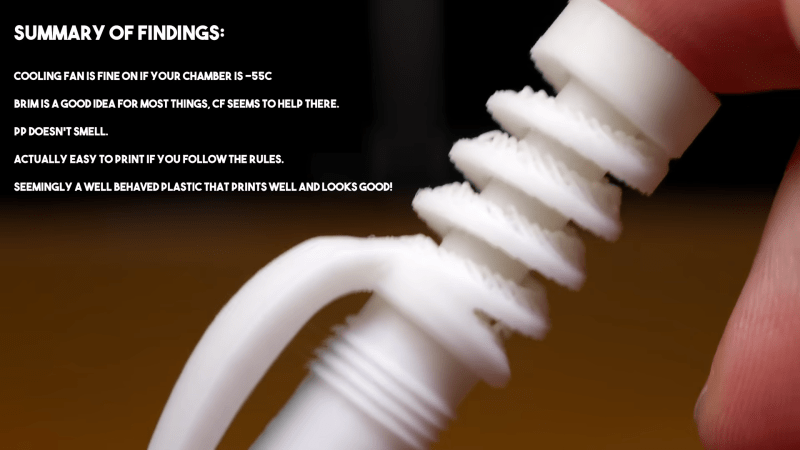Of all the plastics that surround us on the daily, the one we hear least about in the 3D printing world is probably polypropylene (PP). Given that this tough, slightly flexible thermoplastic has characteristics you might want for your prints, the question is: why? [Lost in Tech] is not answering that question in a recent video; instead he’s showing us what we’re missing out on with a review of the material.
A look at the Material Safety Data Sheet and available material has [Lost in Tech] suggesting it won’t be (much) more toxic for you than PLA, but you still wouldn’t want to huff the fumes. The biggest issue printing PP is getting it to stick — glass beds and PEI are not your friend, but polypropylene tape is easy to find and makes a fine print surface. He reviews a few other options, but it looks like plain old tape is still your best bet if you can’t get a hold of a Prusa PP bed. The other big issue is shrinkage, but that’s hardly unique to PP and can be accounted for in the model.
Just because it can be used, that doesn’t mean it should be. [Lost in Tech] does make a good case for why you might want to use PP — for one thing, it doesn’t string much, in part because it’s not hygroscopic. That makes it great for those of us in humid climes who don’t want to always faff around with dry boxes, but also wonderful for parts that will be in touch with water. Polypropylene also has great chemical resistance for even scarier chemicals than dihydrogen monoxide. The “killer app” though, at least as far as [Lost in Tech] is concerned, is to use polypropylene with compliant mechanisms: it’s incredibly resilient to bending, and doesn’t fatigue easily. You might even call it a “flexible” filament, but unlike with TPU, you get a nice hard plastic to go with that flexibility.
If you’re interested in this somewhat-forgotten filament, we featured a “getting started” guide last year. You can even make your own polypropylene filament using non-medical “COVID” masks, but do be sure to wash them first. What do you think? Is it time to give PP another chance, or has the 3D printing world moved on?















Having tried this way back when, the problems were twofold: Layer adhesion and shrinkage. The shrinkage was the killer. It needs a high print temperature, and a high coefficient of thermal expansion. So as it cools down it wants to shrink a lot and tends to go curly on you. Newer blends may be better, but I has an unconvinced.
As mentioned, this is a modelling issue, and one that can be (and has been) accurately simulated since it was used in injection molding. Tool and Die places specialise in this type of modelling and simulation, but slicers don’t handle it or if the box so you need to do the work yourself, but it isn’t terrible. The layer adhesion is a far bigger issue, but good temperatures and perhaps an annealing step could make this manageable. Use a hot bed.
Injection molded parts are fairly limited by their design constraints though, while the whole point of 3D printing is to be able to print arbitrary shapes accurately. Adjusting sliced models for heavy shrinkage would inevitably start conflicting with the features on the models themselves. Shrinkage correction isn’t the silver bullet you think it is, at least for this use-case.
Toll and die maker for inject molds here, the shrinkage issue in cad is solved by simply scaling the original model by the shrinkage factor, for PP we’d use 2%, so you scale your model 1.02 times. Even with Moldflow available to show localized shrinkage, we still resorted to the scaling factor method, unless you are doing a super long aspect ratio, say 20:1, than you gotta do some unequal scaling with bias towards the long axis.
I’m not sure you understand the full problem. In an injection mold, the pp is injected quickly and cools at a reasonably consistent rate as the tool cools so you can compensate with a simple scaling for most parts.
The shrinkage when 3D printing begins on the layers printed first and continues as the part is printed, so the subsequent layers get pulled in. It’s not a consistent shrinkage throughout the model. You end up with parts that have bowed sides. I’m sure you might be able to measure the bowing and compensate somehow in CAD with a logarithmic factor, but it’s not worth the effort unless you’re printing a large number of models and you really need to use pp.
“ Polypropylene also has great chemical resistance for even scarier chemicals than dihydrogen monoxide.” Oh really?
Never underestimate Dihydrogen Monoxide.
Agreed! There is so much pollution that my body is actually mostly made of dihydrogen monoxide! Not an exaggeration, my doctor warned me about it.
I seem to remember polypropylene being good for blocking radiation. I thought I read it was so good for that they were thinking of incorporating it into space suites.
I doubt there are many people here for whom that would be a major selling point but hey.. I bet there is somebody!
Nope! I was thinking of polyethylene. Sorry if you rushed to print your CO-60 container already and already stored it. In that case go get your affairs in order.
When we are stardust, aliens will find a planet with lots of black polypropylene pipe laying around. It appears to be indestructible.